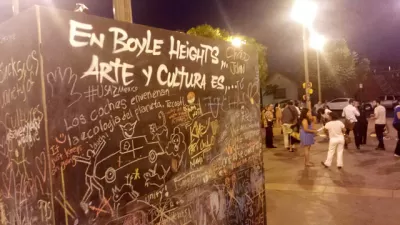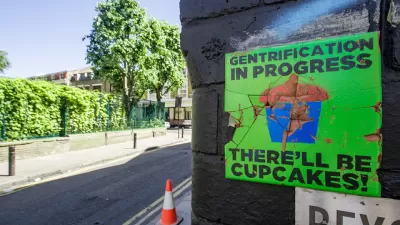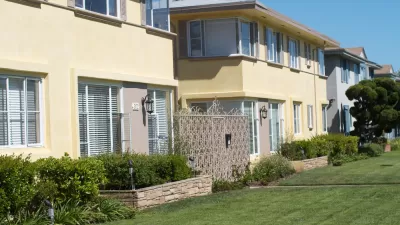The landscape of community development in Los Angeles today differs vastly from even a few years ago. Two groups in East L.A. are developing solutions to accelerating gentrification and displacement and a compounding affordable housing crisis.

Just last month, Rudy Espinoza, executive director of Leadership for Urban Renewal (LURN), shared his experience during the tumultuous situation in Boyle Heights via a blog post titled: "On Defending Boyle Heights." Boyle Heights has recently been the frontline of gentrification and community groups have pushed back from all directions. Over the last decade, the East LA Community Corporation (ELACC) has pushed regional authorities to better engage with low-income communities of color through policy advocacy, defending those who bear the brunt of these development and environmental changes.
Joining The Planning Report for an interview, Rudy sat down with East LA Community Corporation (ELACC) President Isela Gracian to discuss their work on creating a forward-looking community plan for Boyle Heights that protects residents and reflects local needs. They also outline opportunities for innovation in planning, policy, and finance that could help deliver transformative resources to L.A.'s underserved neighborhoods.
Amongst the issues facing the landscape of community development in Los Angeles today are vastly different from even a few years ago. Redevelopment agencies are no longer a resource; the city's planning process is widely agreed to be in crisis; and Los Angeles Metropolitan Transportation Authority has taken on neighborhood-level development alongside its rapid rail expansion.
Gracian, who joined ELACC in 2004, reinforced the importance of having the city of L.A.'s Planning Department strengthen its engagement in community planning. ELACC also focuses on a targeted acquisition strategy in anticipation of the Gold Line extension into East L.A. As of now, ELACC has five developments along the Gold Line that are within comfortable walking distance of a train station. Gracian explains that "as the system expands, similar opportunities will become available in other communities. It’s critical that Metro include strong policies encouraging the development of affordable housing in neighborhoods where that is needed."
Both organizations have used innovative measures to organize support and raise awareness. Gracian and ELACC brought residents to the conversation over a Boyle Heights Community Plan by creating a People's Plan for Boyle Heights and helped transform the tools they were using to engage residents—for instance, by using Legos to demonstrate height and Floor-Area Ratio (FAR). The city's Planning Commission has since adopted the practice as a way to engage more community members.
But how are we going to finance affordable housing for communities on the front-line of gentrification? Espinoza, an urban planner by trade, is having LURN work with ELACC to find alternative financing methods to help people own property. As Espinoza states, "we need to think creatively about how to acquire property that’s community-oriented, and whose management is driven by the needs of the people."
Gracian shares that in ELACC’s work around wealth building, they have found that when low-income families purchase a home—particularly Latino and black families—they tend not to treat it as a "transitional investment." Using that as ELACC's frame of reference allows "for a diversity of homeowners, tenants, business owners, and landowners. Our process has been very successful in bringing those diverse groups together to identify the core issues in the neighborhood and to share their opinions," as Gracian explains.
Read more about how ELACC and LURN are organizing and finding success in working to advance public transportation, community wealth-building, and affordable housing in East Los Angeles in The Planning Report.

Depopulation Patterns Get Weird
A recent ranking of “declining” cities heavily features some of the most expensive cities in the country — including New York City and a half-dozen in the San Francisco Bay Area.

California Exodus: Population Drops Below 39 Million
Never mind the 40 million that demographers predicted the Golden State would reach by 2018. The state's population dipped below 39 million to 38.965 million last July, according to Census data released in March, the lowest since 2015.

Chicago to Turn High-Rise Offices into Housing
Four commercial buildings in the Chicago Loop have been approved for redevelopment into housing in a bid to revitalize the city’s downtown post-pandemic.

New Park Opens in the Santa Clarita Valley
The City of Santa Clarita just celebrated the grand opening of its 38th park, the 10.5-acre Skyline Ranch Park.

U.S. Supreme Court: California's Impact Fees May Violate Takings Clause
A California property owner took El Dorado County to state court after paying a traffic impact fee he felt was exorbitant. He lost in trial court, appellate court, and the California Supreme Court denied review. Then the U.S. Supreme Court acted.

How Urban Form Impacts Housing Affordability
The way we design cities affects housing costs differently than you might think.
City of Costa Mesa
Licking County
Barrett Planning Group LLC
HUD's Office of Policy Development and Research
Mpact Transit + Community
HUD's Office of Policy Development and Research
City of Universal City TX
ULI Northwest Arkansas
Town of Zionsville
Urban Design for Planners 1: Software Tools
This six-course series explores essential urban design concepts using open source software and equips planners with the tools they need to participate fully in the urban design process.
Planning for Universal Design
Learn the tools for implementing Universal Design in planning regulations.






















